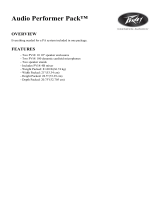
PV500-1 08/15 4 Section 1
2.
INTRODUCTION
This manual covers installation, operation and maintenance on all PVI commercial water heaters and storage tanks. Read
all instructions thoroughly before attempting to start any unit.
CAUTION: Factory authorized start-up may be required on this equipment. Labeling on the unit will indicate this
requirement.
City, state and national codes governing installation of commercial water heaters and storage tanks must be followed and
take precedence over recommendations in this manual.
PRODUCT SAFETY INFORMATION
REFRACTORY CERAMIC FIBER PRODUCT
WITH CRYSTALLINE SILICA
WARNING: This product contains crystalline silica, which has been
identified by the International Agency for Research on Cancer (IARC) as
carcinogenic to humans. This product also contains refractory ceramic
fibers, which have been identified by the IARC as possibly carcinogenic to
humans.
Avoid breathing fiber particulates and dust.
RISKS:
• Airborne fibrous insulation is a possible cancer hazard by inhalation.
• Airborne crystalline silica may cause silicosis (lung disease) by inhalation.
• May cause temporary irritation to eyes, skin, and respiratory tract.
PRECAUTIONARY MEASURES:
• Minimize airborne fibers with engineering controls.
• Use NIOSH/MSHA approved respirators as required (see MSDS).
• Wear long sleeved, loose-fitting clothing, eye protection, and gloves.
FIRST AID MEASURES:
Eyes: Flush with water.
Skin: Wash with soap and warm water.
Ingestion: Do not induce vomiting. Get medical attention if
gastrointestinal symptoms develop.
Inhalation: Remove to fresh clean air.
If any of the above irritations persists, seek medical attention.
WARNING: If you are unfamiliar with the safe handling of Refractory Ceramic Fiber products, or if you wish
additional information prior to beginning any disassembly of the water heater that might expose refractory
ceramic fiber materials, contact:
Unifrax Corporation, 2351 Whirlpool Street, Niagara Falls, NY 14305-2413, 1-800-322-2293.
IDENTIFICATION OF REFRACTORY CERAMIC FIBER MATERIALS (The RCF materials are located within the product and not generally
exposed except during service, disassembly or assembly.)
• Insulation Insert: TURBOPOWER
®
water heaters.
• Flue Collector Insulation: TURBOPOWER
®
water heaters.
• Combustion Chamber Insulation and/or Tubesheet Insulation: Atmospheric and Power Gas, VENTURA
®
, MAXIM
™
, POWER VT
™
water heaters.
CODES FOR WATER HEATER & BOILER INSTALLATIONS
ANSI Z223.1 National Fuel Gas Code
ANSI Z83.1 Installation of Gas Piping and Gas Equipment
on Industrial and Certain Other Premises
American Gas Association
NFPA No. 31 Installation of Oil Burning Equipment
ANSI Z95.1 National Fire Protection Association
60 Battery March St., Boston, MA 02210
NFPA No. 54 Installation of Gas Appliances and Gas Piping
CGA B149 Installation Code for Gas
Burning Appliances &
Equipment
CGA B139 Installation Code for Oil
Burning Equipment
National Electrical Code National Fire Protection
Association
Canadian Electrical Code Part 1
All Provincial Ordinances
All State & Local Codes



















